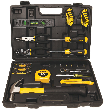Utility sinks can present their own unique problems considering the range of uses that we put them through. Due to these varied uses, using a chemical cleaner can present problems. If you are going to use a chemical cleaner then be sure that you fully read the instructions and only use the cleaner as instructed.
Chemical cleansers are a highly caustic material that can easily cause chemical burns and other forms of damage to your body. They can also cause damage to your pipes, so you'll want to be sure that you use something that is designed to work with your specific type of pipe. You also shouldn't use a plunger on the sink after pouring in the cleaner, as this could lead to potential harm.
When choosing the type of cleaner that you are going to use, keep in mind the different types of clogs that you might be faced with. If you are faced with a clog that is made of primarily biological materials then use a cleaner that is more of an acidic material. If the clog is something that is made up of grease, then use an alkaline cleanser. (You never want to mix the types of cleaners, as it can cause an adverse chemical reaction that can be harmful to people.)
Instead of using a commercial cleaner you may want to use a home-made solution. Simply mix 1/3 cup baking soda with 1/3 cup of vinegar into a pitcher. After mixing the ingredients, follow these simple steps just as if you were using a commercial chemical cleaner.
Determine if the clog is a total blockage or, just a slow drain. If the drain is totally blocked, and there is absolutely no draining at all, then do not use any type of liquid drain cleaner. This is because the cleaner will not remove the blockage and you are going to be faced with a bigger problem of how to remove the now stagnant caustic water from the sink.
After pouring the cleanser into the drain wait for a minimum of five minutes before flushing some regular water down the drain. The blockage should now be cleared up, and if the drain is not working properly still, you may have to take more drastic measures to remove the blockage.

Find the Right Tool Right Away Finally, a homeowner's set that includes all the tools needed to complete basic DIY projects at an affordable price! The tools are stored in a molded case for security and portability. Check out Stanley 65-Piece Homeowner's Tool Kit today!
Unclogging a drain can be something that is extremely messy and difficult for the amateur plumber. Follow these simple ...
Discover MoreSnaking a drain is one of the more sure-fire ways to clear a clog out of any drain. Follow these simple steps, and you ...
Discover MoreUnclogging a drain, such as in your bathroom, does not have to be as difficult as many people think it to be. You do not ...
Discover More2013-01-27 09:42:15
Nels
This is great advise, as a GC I get asked the question..."What can I do to save the cost of having a plumber out to unclog a drain?" My reply is simple, in the kitchen, don't poor grease down the drain. Poor a cleaner down the drain a couple of times a year, depending on the type of food you cook and how often you entertain. This simple hint is something I will be recommended now. Not only is it less expensive, but the home owners most likely already have these two items in the home...one less hazardous chemical they need to worry about with kids or elderly people living in the home.
Thank you for the hint.
Regards,
Nels
Copyright © 2025 Sharon Parq Associates, Inc.
Comments